It’s rare when you discover a truly unique, innovative, and extremely versatile training prop that uses realistic materials for realistic training.
The FireVent® mobile training unit is more than just a ventilation prop. It is a particularly well-thought-out trailer design that allows for a complete multidiscipline “truck company academy” training package.
FireVent® LLC Firefighter Training Equipment was founded in 2009 by retired Carson City (NV) firefighter Rod Temple and his business partner Tom Peters. They recognized the need to provide quality hands-on training to firefighters at their respective fire stations to reduce or eliminate the significant impact involved when fire companies need to travel outside their first-alarm districts to train at the department’s training facility. Travel time and fill-in logistics alone can definitely hinder the ability to get out and realistically train on a regular basis.
The Mobile FireVent trailer can easily be moved from station to station, bringing the training facility to the company rather than the other way around. This enables on-duty crews to conveniently train between calls while remaining in-service.
The FireVent mobile ventilation unit opens and closes with the use of two heavy-duty hydraulic cylinders. With the flip of a switch, it goes from the traveling position to the training position. These same hydraulic cylinders are then used to raise and lower the roofing platform to the desired pitch for training. It can go from a 0° flat roof to a 12/12 pitch (photo 1).

1 Photos 1,3,4 by author.
There are three models available:
- Compact Model, 16 ft. x 12 ft. (4.9 m x 3.7 m) roofing platform ($79,200).
- Standard Model, 20 ft. x 12 ft. (6.1 m x 3.7 m) roofing platform ($83,200).
- Academy Model, 24 ft. x 12 ft. (7.3 m x 3.7 m) roofing platform ($87,200).
These same platform models also come in portable and stationary units, but this article will focus on the mobile Academy model; I feel it provides the most versatility in multidiscipline training evolutions while giving more bang for the buck.
ROOF DECK VENTILATION
The largest part of the FireVent trailer is obviously the open-area roof deck for vertical ventilation training. The perimeter of the roof edge has 16 stanchions with two rows of chains for safety. Portable lighting fixtures can be attached as an added option. Roof coverings can be as simple or as realistic as your department can afford. Typically, 4 ft. x 8 ft. (1.2 m x 2.4 m) sheets of oriented strand board (OSB) or plywood can be used and nailed into the 2-in. x 10-in. (5.1-cm x 25.4-cm) rafters. For more realistic training, the roof coverings can be finished with roofing paper, composite shingles, wooden shakes, or Spanish mission tile. For a real challenge, you could even cover the roof decking using 1- x 6-inch (2.5- x 15.2-cm) shiplap. Metal roofing material can also be attached for cutting metal roofs. Every type of roof cut can be accomplished on this prop: the 4- x 4-foot (1.2- x 1.2-meter) square cut, the 4- x 8-foot (1.2- x 2.4-meter) rectangular cut, the louver cut, the coffin cut, the strip cut, the trench cut, and the Milwaukee cut (photo 2).

2 Photos 2,5,6,7,8,9,10 courtesy of FireVent.
Roof ladders should be used on all operations, and the roof area can easily accommodate four of them. Two cutting stations can operate with plenty of room with close supervision. Sounding techniques and inspection cuts can be practiced for flat roof and pitched roof ventilation. Pulling techniques using the roof hook or the New York hook can also be practiced.
One of the essential saw techniques that is difficult to teach and practice without an acquired structure is rolling the rafters. Rolling the rafter is always part of the first head cut at the ridge. Vertical rafters are often difficult to feel when using a power saw. Cutting through the rafter compromises and weakens the truss. On acquired structures, this can be a costly mistake because you can’t “reset” the truss or the roof. The FireVent has 13 2- x 10-inch (5.1- x 25-cm) rafters spaced 24 inches (61 cm) on-center that can easily be replaced (photo 3).

3
As previously stated, two hydraulic cylinders easily lift the platform from a flat roof to a steep 12/12 pitch. The support posts have incremental numerical signage markers to indicate the exact pitch angle of the roof (photo 4).

4
A 12/12 configuration allows for the practice of cutting a roof from the tip of an aerial ladder (photo 5) or from the edge of the bucket from a tower ladder. Both techniques are more difficult to perform because the objective is to open the roof without placing the firefighter on the roof deck. Movement and reach by the sawyer are restricted, and the aerial operator on the turntable plays a vital part of this evolution. Maneuvering the ladder tip or the platform is a necessary skill set to accomplish adequately sized ventilation holes. The FireVent mobile unit allows this aerial evolution to be practiced regularly with the greatest margin for safety.

5
THE CEILING/ATTIC SPACE
Another important feature on the FireVent trailer is the ceiling/attic space below the roof decking. There are 22 steel hangers for placing 11 2- x 4-inch (5.1-cm x 10.2-cm) ceiling joists. By nailing 4- x 6-inch sheets of OSB , you create the deck for the attic. There is plenty of exposed wood so this space can be enclosed with wood panels or tarps for different drill scenarios. All models come with steel hardware brackets that allow you to hang and build a vertical wall prop on the open side of the attic space. Creating the attic space allows for a whole series of new drills.
PUNCHING DOWN THE CEILING
Often this technique is simulated in traditional training. Depending on the pitch of the roof, this can be an easy or a more challenging evolution. Steeper pitched roofs will require longer roof hooks or pike poles to punch through the ceiling. With enough force, the strikes against the OSB will cause it to fail. For more authenticity, OSB sheets can be screwed into the bottom side of the joist. This causes more of a mess, so it is best to tarp the top of the diamond plate chassis to capture the debris before performing these evolutions. For ease and simplicity, and to use the attic floor, most instructors opt for nailing the OSB on top of the joist. The skill set is to select a tool long enough to reach and strike the ceiling with sufficient force to punch through it while keeping your body out of the vent hole.
GABLE-END VENTILATION
Each model comes with steel brackets and receiving pockets to hang (or build) an exterior wall to simulate the gable end of the attic. Hanging the vertical wall prop against the open attic space allows firefighters to practice gable-end cuts for horizontal ventilation of the attic. Because of the dangers of early collapse of lightweight trusses when exposed to fire, more and more fire departments are limiting the risk to firefighters by prohibiting vertical rooftop ventilation when the objective can be accomplished using horizontal ventilation from the gable end; this is a much safer position for firefighters to operate from, without the risk of falling through the roof (photo 6).
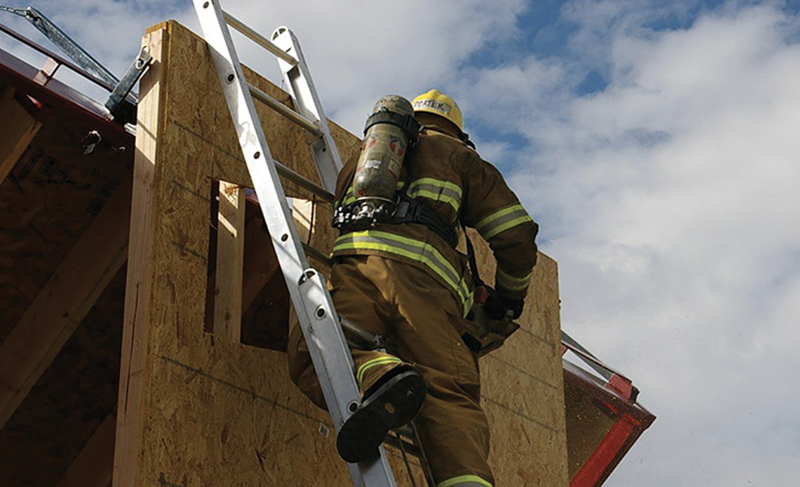
6
MAYDAY AND RAPID INTERVENTION DRILLS
By now, everyone is familiar with the video of the Fresno (CA) fire captain who fell through the roof of a burning garage. Self-arrest techniques by using the roof hook or pike pole to arrest your fall into the attic can be demonstrated and taught. Quick action rescue techniques using the roof ladder to assist the firefighter back up from the attic can be practiced. If the firefighter is unconscious or injured, rapid intervention team (RIT) techniques can be used to breach a hole through the vertical wall prop to access the attic space for firefighter rescue. Additional holes large enough to accommodate the RIT and the placement of ground ladders will need to be created in the wall prop to successfully rescue the firefighter from the attic. This RIT evolution can become quite involved with the use of a stokes litter and rope rescue systems, but the FireVent prop can provide realistic training with the greatest safety margin for all involved.
INDIRECT FIRE ATTACK
Thanks to the Underwriters Laboratories/National Institute of Standards and Technology (UL/NIST) studies, the fire service has a better understanding of flow paths and how ventilation can increase the intensity of the fire without a coordinated attack. Piercing nozzles and round nozzles like the fog applicator are highly underutilized tools, yet they were designed for basement and attic fires. With the FireVent set to a 12/12 pitch, this tactic can be practiced from the roof ladder or from the tip of an aerial ladder or elevated platform. These are just some of the ventilation evolutions that can be performed on the ventilation prop. To increase the challenge, these evolutions can be practiced at night.
CONFINED SPACE RESCUE
A hole can be cut into the roof decking to provide an access opening into the attic space. A-frame ladders or tripods can be rigged over the opening to create high-directional raise and lowering rope systems to meet the training criteria for confined space entry training (photo 7).
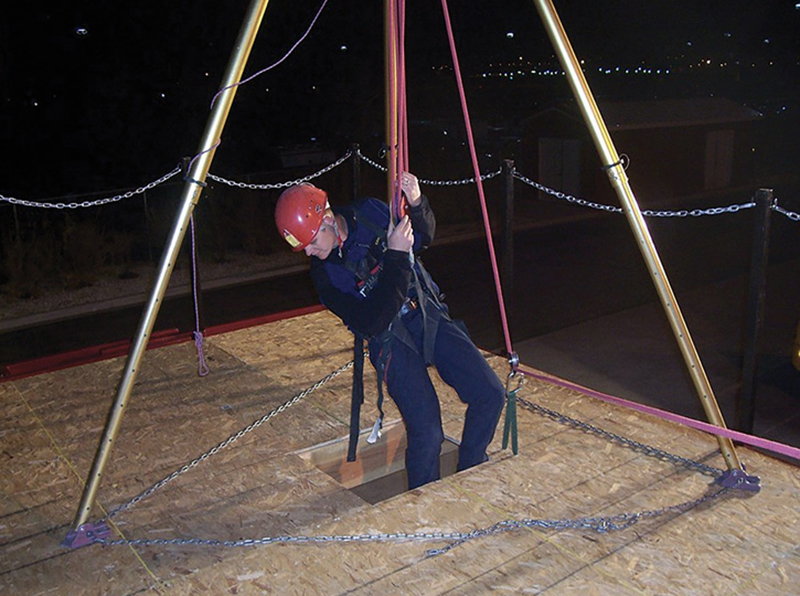
7
SECOND-STORY BAILOUT SYSTEM/LADDER SLIDE
A valuable add-on option is the second-story bailout system and ladder slide. Two steel frames are slid into receiving brackets, creating two window stations. The windowsill is 3 feet (1 m) above the roof deck, and the window opening is 3 feet (1 m) wide and 4 feet (1.2 m) high. Belay systems and anchors can be rigged on the top header of the steel frame for firefighter safety to demonstrate and practice the various firefighter self-rescue ladder bailout techniques (photo 8). This prop could also be used to teach the proper entry and exit techniques for vent-enter-isolate-search (VEIS).
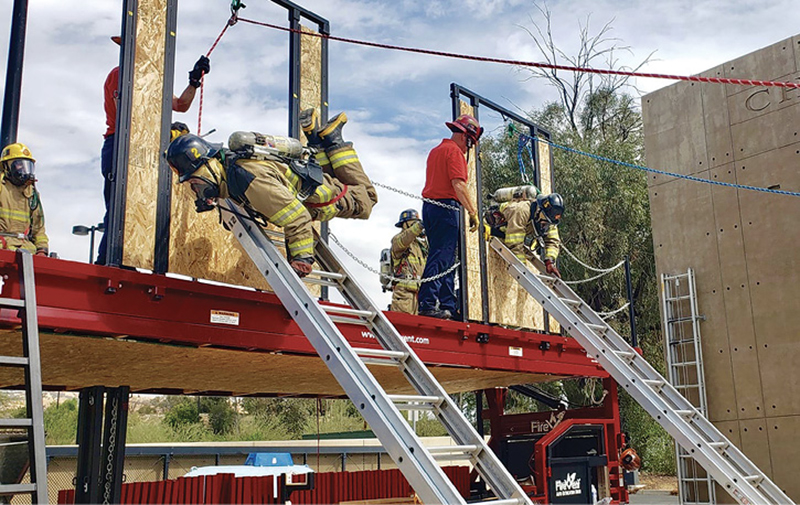
8
FORCIBLE ENTRY
One of the most interesting stations is the forcible entry prop at the rear of the trailer, which consists of two heavy (but cropped) steel doors—one for inward forcible entry prying techniques and the other for outward forcible entry prying techniques using the irons. Constructed similar to traditional steel door ventilation props, the FireVent crops the doors to focus on attacking the locking mechanisms–the critical skill set using the irons. Don’t be fooled; the doors are still heavy and beefy enough to prove challenging. There is no need to hold back striking and prying with the irons. The doors also include a cylindrical lock (doorknob), a rim lock, and a deadbolt lock for practicing through-the-lock skill sets. The locking mechanisms can easily be replaced for the next student (photo 9).
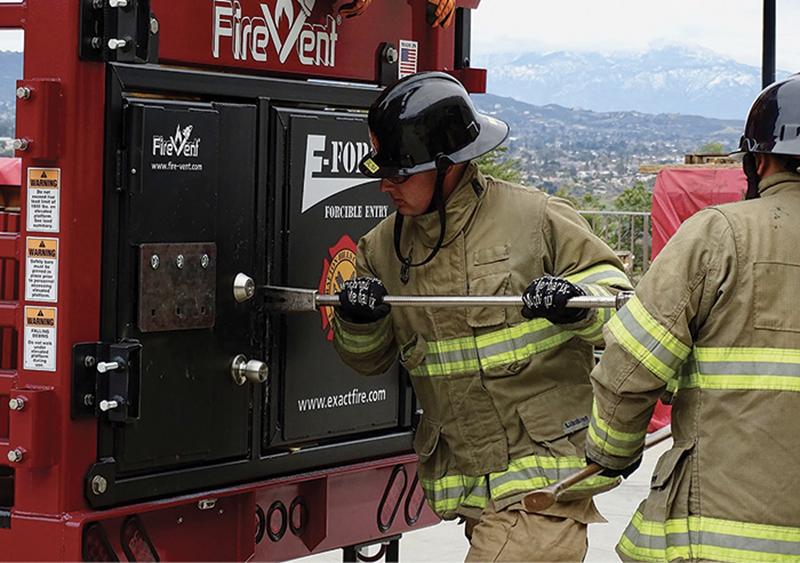
9
A steel plate with six carriage bolts is mounted to the outward swinging door. Cutting through the carriage bolts is another skill set that can be demonstrated and practiced using a circular rescue saw. Small angle steel brackets can be inserted into receiving pockets on the corner of the trailer to attack and cut pad locks and shear door hinges. Two horizontal steel brackets can be attached to the corner of the trailer, which can securely hold 6 rods of rebar. Rebar is used in reinforced concrete and has to be cut with a circular rescue saw using a metal cutting blade to breach through concrete walls and flooring.
OTHER TRAINING EVOLUTION OPTIONS
Additional training options are available with a modest price increase, including an overhead roll-up door cutting station, rope rescue systems (photo 10), activated sprinkler heads, a hazmat dome leak simulator, and an auto extrication simulator.
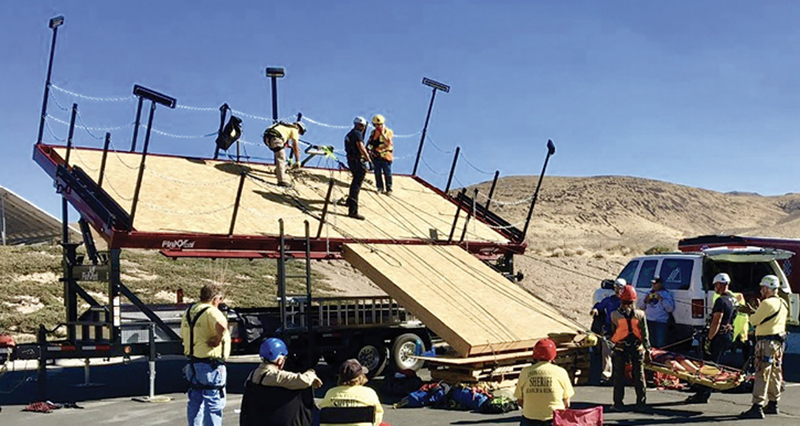
10
CONSTRUCTION FEATURES AND SPECIFICATIONS
The mobile FireVent units are designed to be easily moved from location to location by a ¾-ton pickup or SUV, with no other special equipment needed. Setup and breakdown are quick and easy. Tubular U.S. steel is used for the majority of the construction, providing strength and smooth lines. Certified welders perform all welding to ensure the highest degree of structural integrity as well as visually pleasing welds. All units have been professionally engineered for all load ratings.
The Academy model weighs approximately 9,400 pounds and the gross weight capacity for all models is 12,000 pounds. The overall length is 31 feet and the closed width for all models is 8 feet. The travel height for all models is 10 feet 6 inches.
Other features include a live load limit of 1,800 pounds on any roofing platform at any pitch, LED lights, toolboxes, and 110 volts shoreline power built into the frame of the trailer.
The FireVent mobile training unit can be equipped to be “self-contained” with everything needed for training: saws, ladders, forcible entry tools, etc. This is beneficial so that no equipment is taken off the first line rigs. Companies can train while remaining in-service within their first alarm district and respond to emergencies without delay for retrieving equipment. During inclement or extreme weather, the trailer can be set up inside the apparatus bay for comfortable year-round training.
RAUL A. ANGULO is a captain (ret.) from the Seattle (WA) Fire Department with more than 40 years of experience. He is on the Editorial Advisory Board for Fire Apparatus & Emergency Equipment and the author of the new textbook Engine Company Fireground Operations 4th Edition (Jones and Bartlett Learning).

